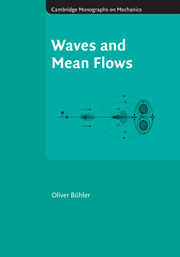Book contents
- Frontmatter
- Contents
- Preface
- Part I Fluid Dynamics and Waves
- Part II Wave–Mean Interaction Theory
- 5 Zonally symmetric wave–mean interaction theory
- 6 Internal gravity waves
- 7 Shear flows
- 8 Three-dimensional rotating flow
- 9 Rossby waves and balanced dynamics
- 10 Lagrangian-mean theory
- 11 Zonally symmetric GLM theory
- Part III Waves and Vortices
- References
- Index
10 - Lagrangian-mean theory
from Part II - Wave–Mean Interaction Theory
Published online by Cambridge University Press: 29 March 2010
- Frontmatter
- Contents
- Preface
- Part I Fluid Dynamics and Waves
- Part II Wave–Mean Interaction Theory
- 5 Zonally symmetric wave–mean interaction theory
- 6 Internal gravity waves
- 7 Shear flows
- 8 Three-dimensional rotating flow
- 9 Rossby waves and balanced dynamics
- 10 Lagrangian-mean theory
- 11 Zonally symmetric GLM theory
- Part III Waves and Vortices
- References
- Index
Summary
We now embark on a journey into new theoretical territory: Lagrangianmean theory based on particle-following averaging. This theory allows a sharper and more succinct description of material advection in fluid dynamics, which greatly simplifies the mean description of material invariants such as scalar tracers or, crucially, of vorticity and potential vorticity. Based on this, Lagrangian-mean theory is superior to Eulerian-mean theory in the description of flow dynamics to do with vorticity and circulation. This will be particularly important for wave–mean interactions outside simple geometry, where long-range mean pressure fields greatly complicate the description of the mean flow based on momentum budgets.
On the downside of Lagrangian-mean theory we need to count the increased structural complexity of the theory, the requirement to evolve particle displacements alongside with the usual flow variables, and the potential breakdown of the particle-following flow map under averaging in the case of large-amplitude waves. Thus whether Eulerian or Lagrangian averaging is more efficient can depend on the problem at hand. As before, we take the view that Eulerian and Lagrangian concepts are complementary to each other in the optimal description of all aspects of fluid motion, and this is certainly true in wave–mean interaction theory as well.
We begin with a general discussion of Lagrangian averaging and of small-amplitude Stokes corrections and then give a comprehensive introduction to the so-called generalized Lagrangian-mean theory (GLM), which formally is not restricted to small-amplitude waves.
- Type
- Chapter
- Information
- Waves and Mean Flows , pp. 204 - 248Publisher: Cambridge University PressPrint publication year: 2009

